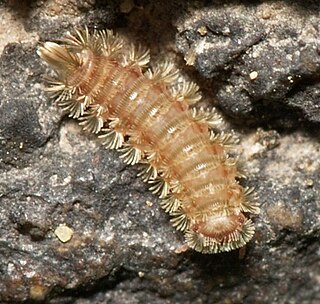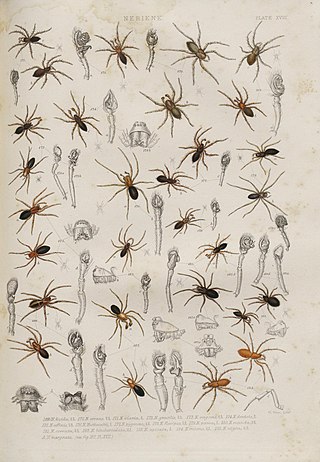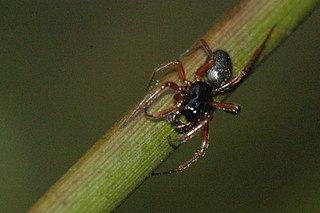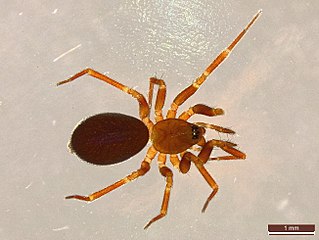
Amaranthaceae is a family of flowering plants commonly known as the amaranth family, in reference to its type genus Amaranthus. It includes the former goosefoot family Chenopodiaceae and contains about 165 genera and 2,040 species, making it the most species-rich lineage within its parent order, Caryophyllales.

Liocranidae is a family of araneomorph spiders first described by Eugène Simon in 1897. They are one of several groups called "sac spiders". The holarctic genus Agroeca is the best-known, but it also includes various genera of more obscure spiders that still lack a diagnosis. Two species in the North American genus Neoanagraphis are found in the extremely dry conditions in the Mojave, Sonoran and Chihuahuan deserts. Females live in animal burrows while males wander and are the ones most often caught in pitfall traps.

Mengeš is a town in the Upper Carniola region of Slovenia. It is the seat of the Municipality of Mengeš. It is located approximately fifteen kilometers from the Slovenian capital of Ljubljana. It includes the hamlets of Zavrti, Veliki Mengeš, Mali Mengeš, and Pristava.

Dwarf sheet spiders (Hahniidae) is a family of araneomorph spiders, first described by Philipp Bertkau in 1878. Their bodies are about 2 millimetres (0.079 in) long, and they build extremely delicate webs in the form of a sheet. Unlike many spiders the web does not lead to a retreat. The silk used in these webs is so fine that they are difficult to spot unless they are coated with dew. They greatly favor locations near water or near moss, and are often found in leaf litter and detritus or on the leaves of shrubs and trees.

Philodromus is a genus of philodromid crab spiders. Spiders in this genus are distinctively flattened.

Amanita calyptroderma also known as coccora, coccoli or the Pacific amanita, is a white-spored mushroom that fruits naturally in the Sierra Nevada mountains and coastal forests of the western United States during the fall, winter and spring.

Drapetisca is a genus of dwarf spiders that was first described by Anton Menge in 1866. Females are 4 to 5 millimetres long, and males are 3 to 4 millimetres long. They are common on tree trunks from July to September, and they feed on insects and smaller spiders.

Chernetidae is a family of pseudoscorpions, first described by Anton Menge in 1855.

Polyxenus is a genus of millipede in the order Polyxenida, containing at least 30 valid species as of 2012.

Lasaeola is a genus of comb-footed spiders that was first described by Eugène Louis Simon in 1881. The type species was described under the name Pachydactylus pronus, but was renamed Lasaeola prona when it was discovered that the name "Pachydactylus" was preoccupied. Both this genus and Deliana were removed from the synonymy of Dipoena in 1988, but many of these species require more study before their placement is certain.

Lathys is a genus of cribellate araneomorph spiders in the family Dictynidae, and was first described by Eugène Simon in 1884. It is a replacement name for "Lethia" Menge, 1869 because that name was already in use as a synonym for a genus of moths.
Mastigusa is a genus of dwarf sheet spiders that was first described by Anton Menge in 1854. As of May 2019 it contains only three species: M. arietina, M. lucifuga, and M. macrophthalma.

Dicymbium is a genus of dwarf spiders that was first described by Anton Menge in 1868.

Gongylidium is a genus of sheet weavers that was first described by Anton Menge in 1868. As of April 2020 it contains three species, found in Asia and Europe: G. baltoroi, G. rufipes, and G. soror.

Helophora is a genus of dwarf spiders that was first described by Anton Menge in 1866.
Leptothrix is a monotypic genus of dwarf spiders containing the single species, Leptothrix hardyi. It was first described by Anton Menge in 1869.

Lophomma is a genus of dwarf spiders that was first described by Anton Menge in 1868. As of May 2019 it contains only three species, found in Canada, Russia, and the United States: L. depressum, L. punctatum, and L. vaccinii.

Microneta is a genus of dwarf spiders that was first described by Anton Menge in 1869.
Tmeticus is a genus of sheet weavers that was first described by Anton Menge in 1868.
Chernes is a genus of pseudoscorpions belonging to the family Chernetidae.
















